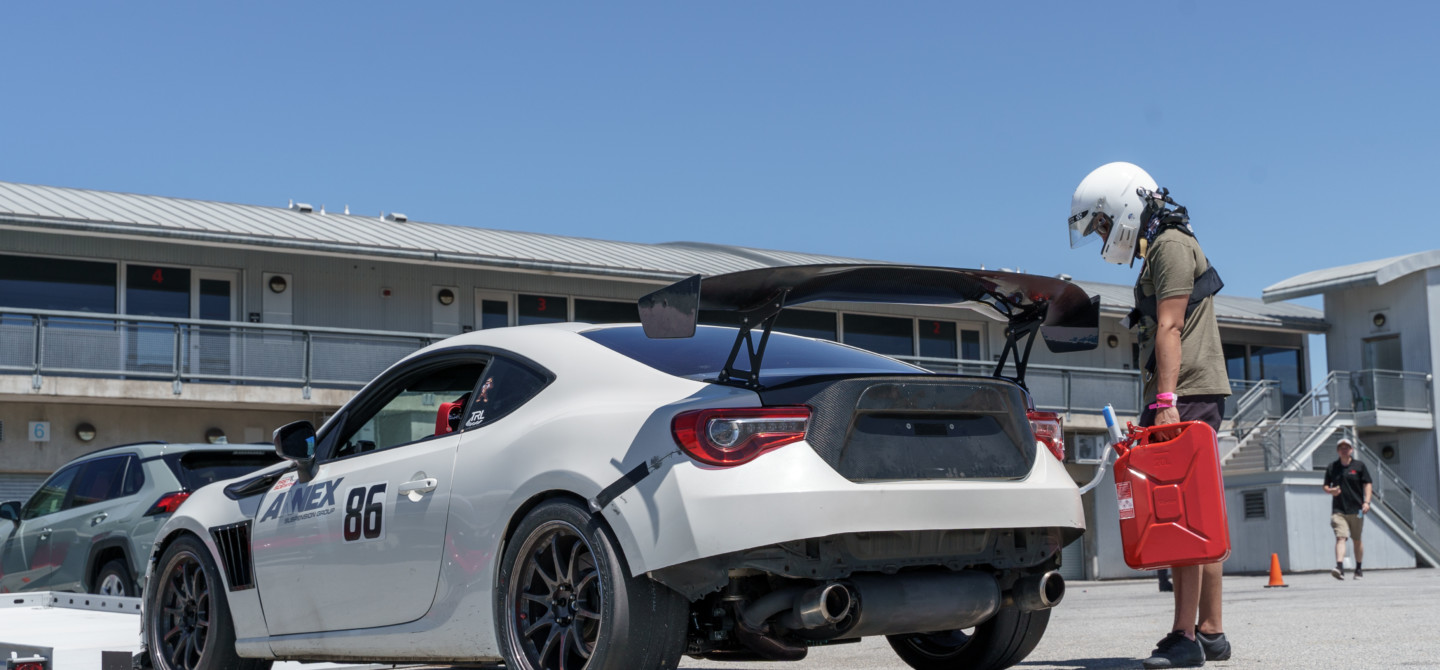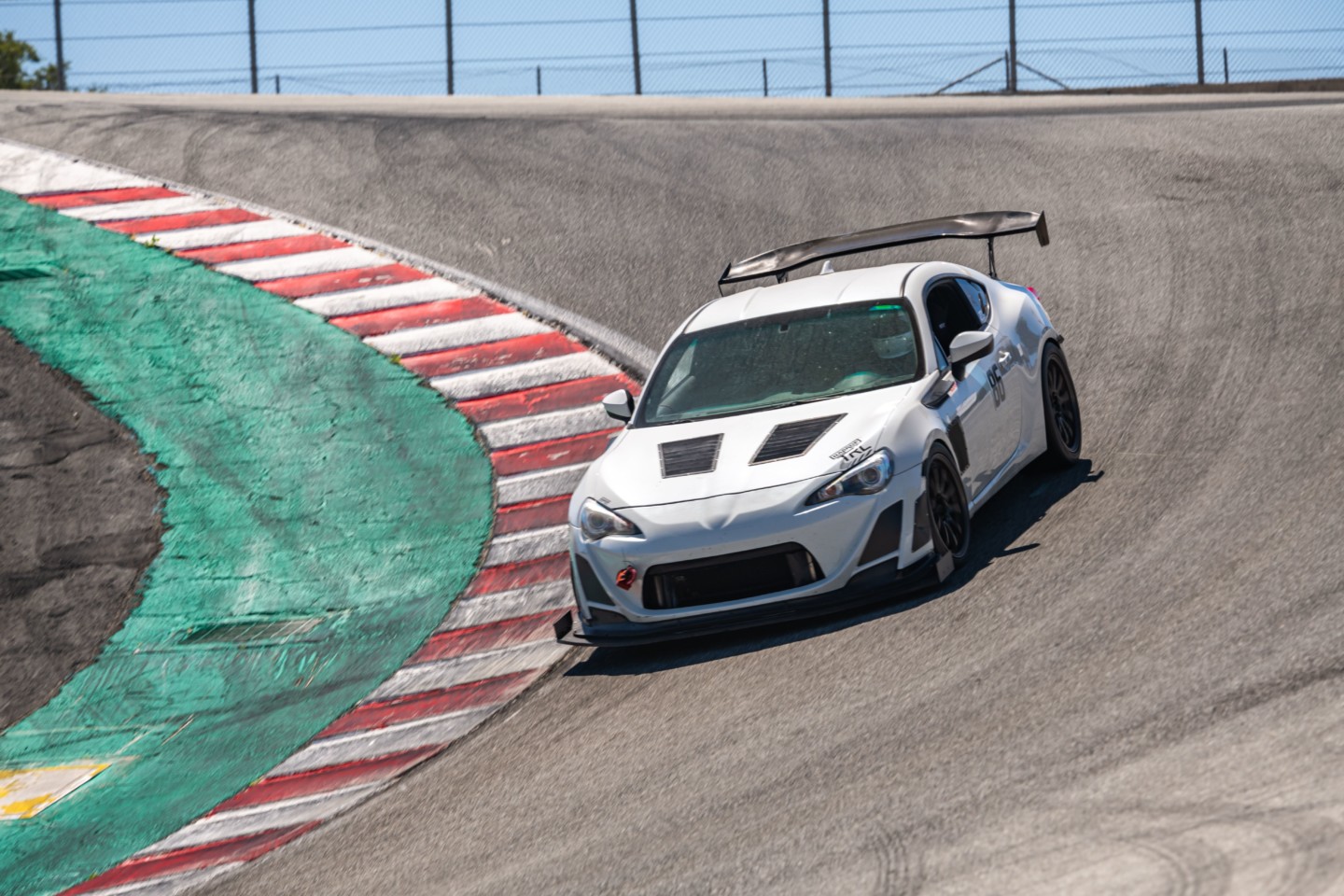There aren’t many budget platforms which can outcorner a BRZ. When the footprint’s widened and the FA20 engine force-fed a little extra air via a Harrop supercharger, it transforms from momentum car to formidable machine with the right amount of grip, power, and playfulness to make it fast and fun. On 13 pounds of boost and a tank full of E85, the once-anemic motor makes a respectable 360 horsepower at the rear wheels—more than enough to propel its 2,720 pounds along Laguna Seca’s long straights.
Since we last saw Kevin Schwiegert’s BRZ in action, he’s made a few changes. The latest iteration of the BRZ uses Annex Suspension Group ClubSpec Pro one-way coilovers, ST front and rear sway bars, a broader front splitter, CSG Spec C2 brake pads, and some driving habit changes. It’s perhaps those changes which have helped him hound a GT3 RS during a track day at Laguna Seca and set the fastest time of any car that day.
“In analyzing data, I have found that my cornering speeds were lacking compared to other vehicles clad in similar rubber, so I consulted some more experienced drivers (Nik Romano and Joe McGuigan). With their help, I have been working on carrying more speed into corners and being more patient getting back to throttle. Adjusting the balance between trail braking and maintenance throttle through turns has been very interesting and enlightening,” Schweigert begins.
Pushing the Phases Forward
The area of focus differentiated heavy trail braking use all the way to apex against less trail braking and early maintenance throttle to keep speed from falling. Some call the latter approach “throttle steering.”
“Earlier, I was not carrying enough speed into corners and was going to maintenance throttle a little too soon. I was doing more of a slow-in, fast-out approach where I was overslowing the car and relying on throttle to carry me through. At this event, I started trail braking a little harder and deeper while carrying more speed into the turn,” he continues.
Romano elaborates on what’s happening by pushing the braking phase further down the road. “By braking later, which in turn means braking further into the turn, you force the trail braking to happen. By doing this, you reach a higher terminal speed on the prior straight, you keep the nose of the car planted with the trail brake, thus getting it pointed to the apex sooner/more efficiently, and you eliminate the automatic reflex—or even the option to do so—to go back to the gas too soon!”
As long as the driver is comfortable dealing with some minor countersteering due to greater weight transfer at the beginning of the braking phase, getting the car turned in neatly is usually simplified by braking later.
The Work’s Not Done Yet
Even with a Cusco LSD and 275-section Maxxis RC-1 R2 tires in the rear, Schweigert still has some difficulty deploying that power when the corner is overslowed. So, with this greater weight transfer carried later into the corner, Schweigert has to exercise even more caution when prodding the throttle pedal. To transfer the weight more gradually, he must be progressive with the right foot.
Even with this restrained application, having the car on-edge results in a several big snaps (0:41, 1:25) which showcase Schweigert’s excellent countersteering abilities. Because the rear is already well settled with a moderate amount of throttle by the time these bumps upset the car in those two instances, the lateral movement is minimal and the forward drive still strong. It’s only in Turn 11 (1:39) when he reverts to a greedy stab of the throttle, and we can see how slowly he leaves the hairpin compared to the Porsche ahead.
Even when keeping the Subaru reasonably straight, Schweigert can’t hope to match the Porsche in corner exits, but his entry speeds keep the two in touch. Just observe the ground made up into Turn 5 (0:50) and Turn 10 (1:28). From entry to apex, Schweigert’s undeniably quicker, and that’s enough to help him across the line in 1:35.966. Clearly, big improvements can be had with good coaching and a hare to chase.
























